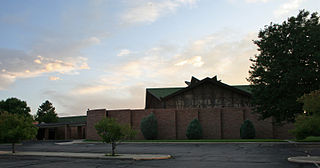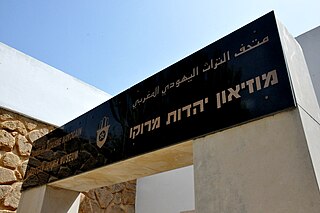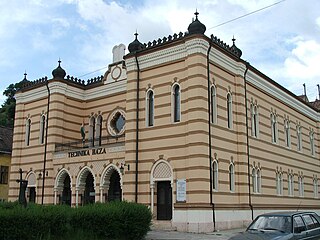
Tangier or Tangiers is a city in northwestern Morocco, on the coasts of the Mediterranean Sea and the Atlantic Ocean. The city is the capital of the Tanger-Tetouan-Al Hoceima region, as well as the Tangier-Assilah Prefecture of Morocco.

The history of the Jews in Morocco goes back to ancient times. Moroccan Jews constitute an ancient community. Before the founding of the State of Israel in 1948, there were about 265,000 Jews in the country, with a maximum of between 250,000 and 350,000 at its peak in the 1950s, which gave Morocco the largest Jewish community in the Muslim world, but by 2017 only 2,000 or so remained. Jews in Morocco, originally speakers of Berber languages, Judeo-Moroccan Arabic or Judaeo-Spanish, were the first in the country to adopt the French language in the mid-19th century, and unlike among the Muslim population French remains the main language of members of the Jewish community there.

The history of the Jews in Portugal reaches back over two thousand years and is directly related to Sephardi history, a Jewish ethnic division that represents communities that originated in the Iberian Peninsula. In the sixteenth and seventeenth centuries, Portuguese Jews emigrated to a number of European cities outside Portugal, where they established new Portuguese Jewish communities, including in Hamburg, Antwerp, and the Netherlands, which remained connected culturally and economically, in an international commercial network during the seventeenth and eighteenth centuries.

Moorish Revival or Neo-Moorish is one of the exotic revival architectural styles that were adopted by architects of Europe and the Americas in the wake of Romanticist Orientalism. It reached the height of its popularity after the mid-19th century, part of a widening vocabulary of articulated decorative ornament drawn from historical sources beyond familiar classical and Gothic modes. Neo-Moorish architecture drew on elements from classic Moorish architecture and, as a result, from the wider Islamic architecture.

The Ibn Danan Synagogue is an Orthodox Jewish congregation and synagogue, located in Fes, Fès-Meknès, Morocco. The synagogue is located in the Mellah district within Fes el-Jdid, one of the components of the historic medina of Fes.
Amazonian Jews are the Jews of the Amazon basin, mainly descendants of Moroccan Jews who migrated to northern Brazil and Peru in the 19th and early 20th centuries. The migrants were attracted to the growing trade in the Amazon region, especially during the rubber boom, as well as to the newly established religious tolerance. They settled in localities along the Amazon River, such as Belém, Cametá, Santarém, Óbidos, Parintins, Itacoatiara and Manaus in Brazil, some venturing as far as Iquitos in Peru.

The Włodawa Synagogue is a former Orthodox Jewish congregation and synagogue complex, located at 5-7 Czerwonego Krzyża Street, in Włodawa, in the Lublin Voivodeship of Poland. The synagogue complex comprises the Włodawa Great Synagogue, the Small Synagogue or Beit midrash, and a Jewish administrative building, all now preserved as a Jewish museum.

The Temple Emanuel, also known as Congregation Emanuel, is a Reform Jewish congregation and synagogue, located at 51 Grape Street, in Denver, Colorado, in the United States.

The Hechal Yehuda Synagogue, also commonly known as the Recanati synagogue, often referred to as the Seashell Synagogue because of its unusual shape resembling a seashell, is an Orthodox Jewish congregation and synagogue, located on Menahem ben Saruq street, in the city centre of Tel Aviv, Israel.

Moroccan Jews are Jews who live in or are from Morocco. Moroccan Jews constitute an ancient community dating to Roman times. Jews began immigrating to the region as early as 70 CE. They were later met by a second wave of migrants from the Iberian Peninsula in the period which immediately preceded and followed the issuing of the 1492 Alhambra Decree, when Jews were expelled from Spain, and soon afterward, from Portugal. This second wave of immigrants changed Moroccan Jewry, which largely embraced the Andalusian Sephardic liturgy, to switch to a mostly Sephardic identity.

Rue Es-Siaghine is a street in Tangier, Morocco. Under Roman rule it was the decumanus maximus, the main thoroughfare of the city. The street led to the harbor through the south gate. Today the street is lined with cafes, bars and souvenir shops, and leads down into the Petit Socco in the medina of Tangier.

The Petit Socco, also known as the Place Souk Dakhel, or in Spanish as Zoco Chico, is a small square in the medina quarter of Tangier, Morocco.

The Beth Yaacov Synagogue, also known as the Beth Jacob Synagogue or the Synagogue of Madrid, is a Jewish congregation and synagogue, located at 3 Calle Balmes, in the Chamberí district of Madrid, Spain. When it opened in 1968, it was the first new synagogue building built in Spain since the Catholic Monarchs of Spain expelled the country's Jews in 1492.

The Kadoorie Mekor Haim Synagogue, also the Porto Synagogue, is an Orthodox Jewish congregation and synagogue, located at 340 Guerra Junqueiro Street, in the civil parish of Lordelo do Ouro e Massarelos, the municipality of Porto, in the northern region of Portugal.

The Museum of Moroccan Judaism is a museum of Jewish life in Morocco in Casablanca, Morocco.

The Cytron Synagogue, also known as the Beit Midrash Cytron, is a former Orthodox Jewish congregation and synagogue, located at 24a Ludwika Waryńskiego Street in Białystok, in Podlaskie Voivodeship, Poland. Completed in 1936 in the Modernist style, the construction was funded by Shmuel Cytron, it served as a house of prayer until World War II; subsequently used for profane purposes, and as the Sleńdzińscy Gallery, an art gallery.

The Esztergom Synagogue is a former Jewish congregation and synagogue, located in the town of Esztergom, Hungary. The synagogue was built in 1859, renovated in 1888, and severely damaged by a bombing during World War II. Since almost all Jewish people in the town were deported during the Holocaust and Communists subsequently gained control of the country, the building has not been used for religious purposes since the 1940s.

Haim Benchimol was a Moroccan businessman, newspaper publisher, Jewish community leader and philanthropist in Tangier, Morocco. In 1904 he founded the Benchimol Hospital, at the time one of Tangier's main hospital facilities, which remained in activity until 2002.

















